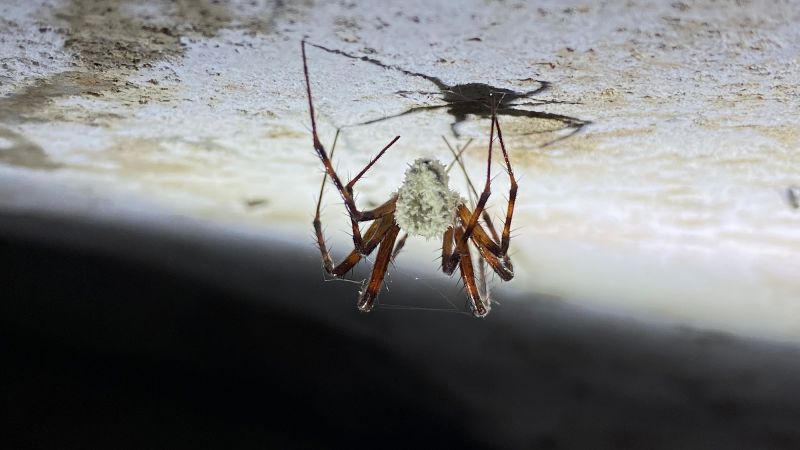
Subscribe to CNN’s Wonder Theory science newsletter. Delve into the cosmos with updates on intriguing discoveries, scientific innovations, and more.
CNN —
Researchers from Europe have uncovered a new species of fungus that transforms cave spiders into “zombies.” This fungus entices the spiders from their webs, leading them to an early demise, after which it utilizes their remains to disseminate its spores.
The newly identified species, called Gibellula attenboroughii, exhibits behavior reminiscent of the zombie ant fungus, effectively manipulating its prey to position itself in areas that enable optimal spore dispersal, as revealed in a study published on January 24 in the journal Fungal Systematics and Evolution.
The mechanisms by which the fungus influences the spider’s brain remain largely unexplored, leaving numerous questions about its evolutionary journey and ecological role unanswered.
“We are quite familiar with ants, wasps, and a handful of other organisms; however, this is from a different family, indicating a novel origin for behavior manipulation,” remarked Dr. João Araújo, a mycologist at the Natural History Museum of Denmark and assistant professor at the University of Copenhagen. “This finding presents a fascinating case, as such phenomena are not very common among parasites.”
This discovery paves the way for additional research into fungi that control animal behavior and highlights the extensive diversity of fungi yet to be explored, according to the researchers involved.

This newly discovered fungus is part of a broader category of fungi that exclusively species spiders.
Researchers have previously observed another Gibellula species (G. aurea, found in Brazil) that may direct spiders to the undersides of leaves prior to death, as detailed in a November 2022 study co-authored by Araújo. However, the behavior exhibited by G. aurea was not as striking compared to what occurs with G. attenboroughii targeting cave-dwelling spiders.
So far, G. attenboroughii has only been documented infecting the orb-weaving spiders Metellina merianae and Meta menardi, both of which inhabit caves in Europe.
The initial discovery of this unique fungus has an intriguing backstory: In 2021, a film crew first came across the fungus on an orb-weaver spider while filming in an abandoned gunpowder storage facility located in Castle Espie Wetland Centre, County Down, Northern Ireland.
The crew observed that the spider had positioned itself in an exposed area prior to dying, away from its web, which suggested that the fungus had altered its behavior.
Subsequent observations revealed an increasing number of infected spiders in various caves across Northern Ireland and Ireland, all situated in exposed areas on the cave ceilings or walls.

“Most web-building spiders prefer to stay within their webs, as they are uniquely adapted for that environment, and often struggle to navigate on the ground,” noted Dr. Jay Stafstrom, a postdoctoral researcher at Cornell University specializing in arachnid sensory ecology.
“The concept of a fungus infecting an organism and then altering its behavior to aid in spore dispersal is incredibly intriguing,” said Stafstrom, who did not participate in the study.
The research team currently lacks clarity on the inner workings and specific mechanisms of the fungus. Still, they propose that it may draw the spiders out of their protective habitats into areas exposed to airflow, which would facilitate spore distribution, according to Araújo, a research associate at the Royal Botanic Gardens, Kew.
The researchers have yet to determine the specific metabolites—the compounds synthesized by the fungus that interact with other organisms—that G. attenboroughii is producing within the host’s brain. Further investigation is necessary to assess the fungus’s ecological implications, but Araújo believes there’s no immediate cause for alarm regarding the affected spider species.
“Fungi have been evolving for over 100 million years, coexisting alongside spiders and various other fungi and insect species,” Araújo explained.
“We can hypothesize that they contribute to ecological balance,” he continued, referencing the case of zombie ant fungiscientists have studied that help regulate insect populations.
Although approximately 150,000 species of fungi have been officially cataloged, experts estimate this figure represents only about 5% of the total fungal diversity thought to exist. Dr. Matthew Nelsen, an evolutionary biologist and research scientist at Chicago’s Field Museum, who was not involved in the current study, expressed that “this research highlights the challenge of documenting fungal species and will stimulate further efforts to bridge this gap.”
The research team also observed mycoparasites consuming the zombie spider fungus, emphasizing the ecological importance of these spiders as a food source for fungi, thereby supporting other fungal species. “This underscores the intricate and varied ecosystem around us,” Nelsen added.

The idea of zombie fungi can easily bring to mind horror stories, especially when compared to sci-fi scenarios such as in HBO’s “The Last of Us,” which takes inspiration from the zombie ant fungus. However, humans do not need to fear Gibellula attenboroughii, according to Nelsen.
“While some cave-dwelling fungi can pose risks to humans, this particular group affects only spiders. For it to evolve a capability to infect humans, it would need to adapt to our warmer body temperatures and evade our immune systems, both of which serve as significant barriers against most fungi,” he noted.
Araújo and his team intend to persist in their study of spider-infecting fungi to decipher their relationships, origins, and evolutionary paths. Gaining deeper insights into these fungi could eventually open doors to practical applications in agricultural pest control and potentially human medicine.
“Consider a fungus that can modify spider behavior; the metabolites it releases may provide revolutionary insights, potentially aiding in the treatment of Alzheimer’s and other neurodegenerative conditions,” Araújo suggested. “Such possibilities are indeed promising.”









